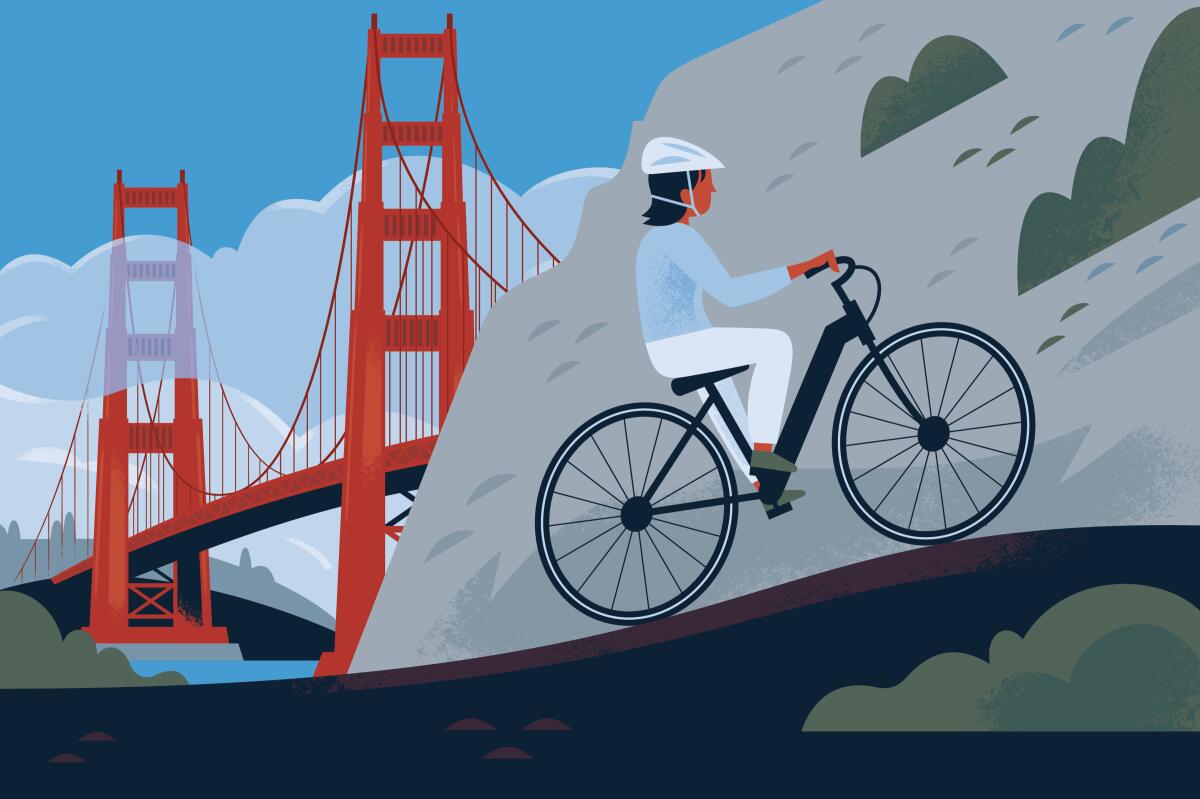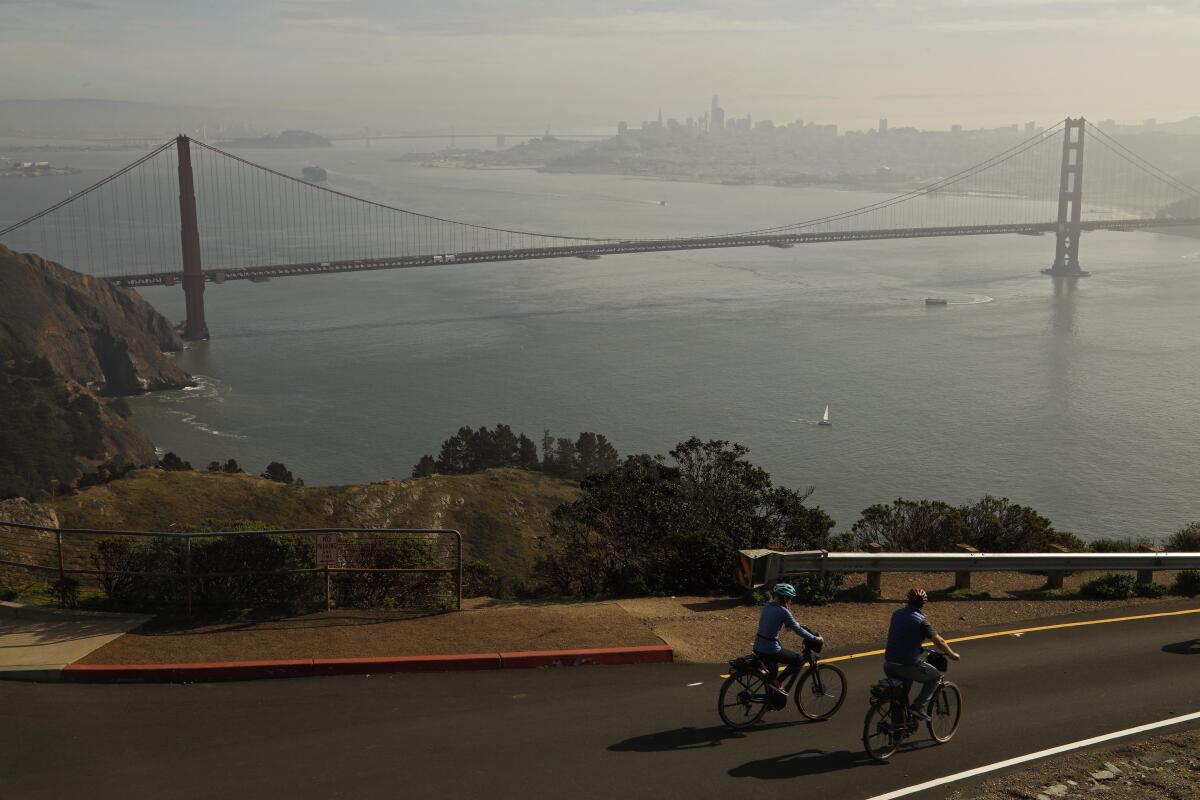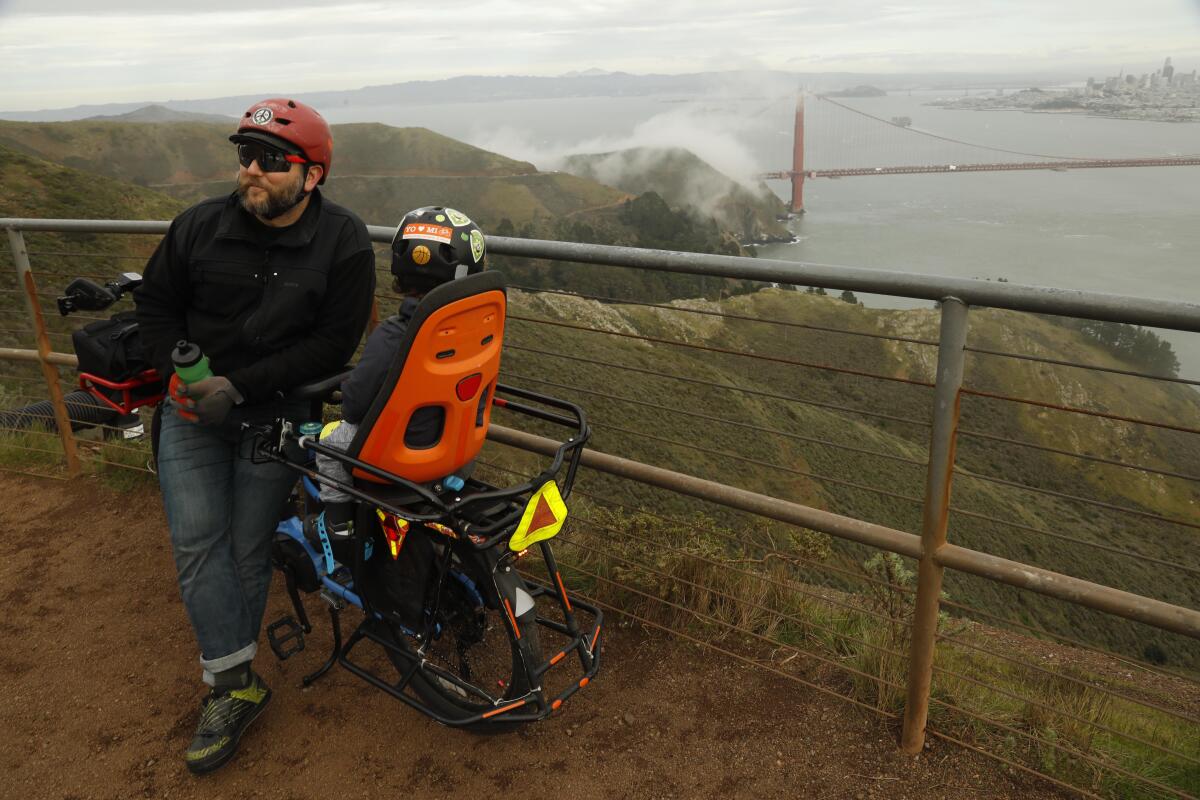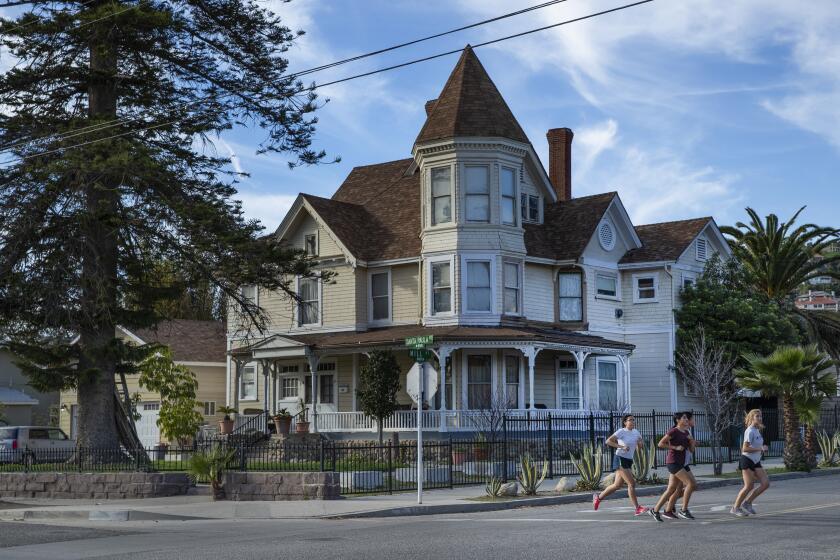I had tons of fun riding an e-bike in a national park. I also broke the law. Oops

- Share via
GOLDEN GATE NATIONAL RECREATION AREA, Calif. — I recently violated federal law high in the Marin Headlands overlooking the Golden Gate Bridge.
How? By riding an electric bike for a mile along the Julian Trail, part of the Golden Gate National Recreation Area. The trail is popular with hikers, mountain bikers and equestrians.
It was an accident. That old fire road is part of a vast regulatory muddle involving (a) a global boom in e-biking, especially among travelers; (b) a sudden move in August by the Trump administration to ease e-bike access to public lands; (c) an opposing lawsuit by environmental groups; (d) the labors of dozens of national park superintendents to tailor the new policy to their parks; and (e) National Park Service red tape.
As it turns out, e-bikes are multiplying faster than public agencies can make rules to regulate them, with estimated U.S. sales of $144 million in 2018. Consulting firm Deloitte predicts 130 million e-bikes will be sold worldwide in 2020-23.
When it comes to national parks and California state parks, the rules are often site-specific. If you’re thinking of taking an e-bike somewhere cars can’t go, the prudent move is to check the National Park Service’s FAQs and the specific park’s website, then call for clarification. If you’re renting an e-bike, don’t rely on the rental company to know the law.

Was I prudent? Well, I thought so. I read the Aug. 30 NPS policy memorandum directing park superintendents to ease e-bike access “as soon as possible” and a detail-laden Golden Gate National Recreation Area explanation of how park e-bike rules were evolving. I talked to cyclists. I left phone and email messages with the recreation area’s public information office.
But the Golden Gate National Recreation Area, the busiest unit in the national park system, is complicated.
“There are a lot of great conversations happening at the local and national level around this issue,” Golden Gate spokesman Charles Strickfaden said in an email that arrived after my ride, “so we cannot give a time frame for when we expect to finalize any e-bike approval. Until that time Golden Gate NRA cannot allow e-bikes [beyond the roads] in the parks it manages.”
Oops.

Come to think of it, I saw mountain bikes, gravel bikes and hikers on that trail. I saw e-bikes on the road, but no other e-bikes on that trail. I’m pretty sure the rest of my ride was legal, though.
Back on the daunting slope of Conzelman Road (legal for cars and all kinds of bikes), I felt exhilarated but oddly coddled as the e-bike motor boosted the effect of my pedaling. The views were breathtaking — the sea, the city, the bridge, the creeping fog — and my respiration was untroubled.
A historic inn, tasty barbecue and an abundance of museums highlight close-to-home Santa Paula and the Santa Clara River Valley.
In fact, with the little motor humming just above my rear wheel, the killer climb to Hawk Hill was no problem. No wonder e-bikes are multiplying.
“We’re seeing more and more of them almost every day,” Tom Boss, off-road and events director for the Marin County Bicycle Coalition, had told me a few days before.
Many traditional cyclists were “initially skeptical” about the bikes, Boss said, but “we’ve definitely evolved on it. And the reality is, they’re here. If they’re going to be out there, we want to lead on education and trail etiquette.”

I met Kimball and Wendy Thomas, 40 and 39, respectively, of San Francisco as they prepared to zoom down from Hawk Hill with two friends visiting from São Paulo, Brazil.
The Thomases were on traditional bikes, but their friends, Lucas and Renata Lima, had just crossed the Golden Gate Bridge and climbed the hill on e-bikes rented in the Presidio.
“Great! Sent from God!” Lucas, 30, said of his ride. “We’re not here to do sport. We’re here to look around and enjoy ourselves.”
Immerse yourself in the places that found a way into your heart, except in one case, and then you’ll have to settle for dinner.
And, said Renata, 32, “There’s nothing difficult about it.”
Although his guests were happy, Kimball said he saw plenty of reason for caution about e-bikes. If you’re limited to the speed your legs can deliver, he said, you have a lot of kinetic awareness of yourself and your bike, “and there’s a safety to that. On the e-bike, you lose some of that.”
The motor adds about 20 pounds, so my e-bike was more cumbersome than any road or mountain bike I’ve tried. But it was quiet, used no fossil fuel and emitted no pollution. These bikes, boosters say, will allow more of us to see more of the natural world.
“This enables our lifestyle,” said Matt Dove, a 41-year-old San Francisco dad who sat atop an e-bike with his 3-year-old son strapped (and helmeted) in a child seat.
Dove, who runs a youth bike education program, said he’d spent most of his life working and playing around bikes and had started e-biking about a year ago.
“Kids that grow up in an urban context need to be taught or welcomed to love nature, and sometimes that means removing barriers,” he said. Moreover, he said, nodding at his bike and then his son, “this thing will allow us to keep riding together as my knees give out.”
For others, the administration’s e-bike green light is a hastily imposed, potentially dangerous intrusion into territory that’s always been engine-free.
Former National Park Service Director Jonathan Jarvis called the move part of the “systematic dismantling of a beloved institution, like pulling blocks from a Jenga tower, until it collapses.” (His opinion piece, which appeared Jan. 10 in the Guardian, was co-written by his brother, public lands advocate Destry Jarvis.)
The change could bring increased noise, trail damage, disturbance of wildlife, “high speeds, increased likelihood of collisions … and the startling and disturbance of hikers, runners, and horse and traditional bicycle riders,” advocacy group Public Employees for Environmental Responsibility contends in its lawsuit seeking to block the new e-bike policy.
In that action, filed Dec. 5 in the U.S. District Court for the District of Columbia, the group is joined by three individuals and the organizations Wilderness Watch, Marin Conservation League, Environmental Action Committee of West Marin and Save Our Seashore.
Starting Wednesday, a big stretch of Market Street will be devoted to streetcars, buses, cyclists and pedestrians.
The groups say the new policy conflicts with existing regulations, should have been preceded by environmental review, and is improper because the Interior Department and NPS officials who issued the policy lacked the authority to do so.
P. Daniel Smith, the NPS acting director who issued the policy, stepped down in September and was succeeded by Deputy Director David Vela.
“We strongly disagree with the premise of PEER’s lawsuit and will continue to work with park superintendents to implement our common-sense e-bikes policy,” said an NPS spokesperson in Washington, D.C.
What’s an e-bike?
E-bikes, introduced more than two decades ago, have pedals and look like traditional bikes but have small motors (typically up to 1 horsepower) that cut off once the bike reaches 20-28 mph, depending on the model.
Some motors are triggered by the use of the pedals; others have throttles on the handlebars like a motorcycle and require no pedaling.
The National Park Service’s new policy requires that e-bike riders use their pedals, prompting this rejoinder from parks watchdog Kurt Repanshek of Nationalparkstraveler.com: “So, how many park rangers will be needed to monitor whether [e-bikers] are pedaling or not?”
Plans unveiled for a proposed major makeover of Hollywood Boulevard would limit auto traffic and create a less gritty experience for visitors.
By 2015, tens of millions of e-bikes were rolling in China. In the last few years, prices for low-end models have fallen below $1,000 in the U.S., more mountain-bike-style models have appeared and sales are zooming. The sales-tracking NPD Group reported that e-bike sales jumped 91% in 2017, then 72% in 2018 (to $144 million for the year).
Many of these cyclists will be travelers. One recent survey found that tour operators were offering e-bikes on trips to the Natchez Trace, Namibia, the Swiss Alps, several Italian islands, Taiwan and the covered bridges of Vermont.
At VBT Bicycling Vacations, a Vermont-based tour operator that takes small groups on cycling trips in North America and Europe, e-bikes are now offered on 56 of the company’s 58 tours. In bookings for the year ahead, brand manager Ashlea Sullivan said, 37% of guests are requesting e-bikes instead of conventional bikes.
Where can an e-bike go in state and national parks?
In August, U.S. Interior Secretary David Bernhardt issued an order to increase e-bike access to land controlled by the Department of the Interior, including national parks and wildlife refuges. A day later, the NPS issued its policy memorandum directing parks to comply as soon as possible.
But the memo gave park superintendents the option of banning e-bikes from some bike routes for safety reasons.
An electric-assist bike makes a 33-mile spin around Crater Lake and through the Oregon Cascades a pleasant experience rather than a sweaty grind.
Since then, superintendents have scrambled to sort out details and exceptions. At least two dozen national parks have new e-bike rules in place — some with exceptions, some without — and more are expected in coming weeks.
Don’t expect to find e-bikes invading trails set aside for hikers. Nobody has proposed that. But in many parks, they can go everywhere old-fashioned bikes are allowed.
The speed limit on those routes is often 15 mph, a rate that both kinds of bikes routinely surpass when heading downhill.
•In the Santa Monica Mountains National Recreation Area, e-bikes are allowed everywhere that motor-less mountain bikes and road bikes go.
•In Joshua Tree National Park, cyclists are forbidden on hiking trails but permitted on roads open to vehicles.
•In Death Valley National Park, e-bikes are not mentioned on the “biking” web page most visitors consult, but the park’s compendium — a collection of park-specific rules set by the superintendent — affirms that e-bikes can go anywhere conventional bikes go. Thus, they’re banned from all trails and wilderness areas and permitted on all roads (some paved, some gravel) open to the public. They are also permitted on the mile-long path between the Furnace Creek Visitor Center and the Harmony Borax Works.
A mind-blowing children’s museum, a pedal-a-thon in a surrey and great eats make for a can’t-miss weekend in Santa Barbara.
•In Yosemite National Park, all bikes are banned from hiking trails and wilderness areas but allowed on regular roads. And for the moment, e-bikes cannot join conventional bikes on Yosemite Valley’s more than 12 miles of bike paths.
But in coming weeks, when the acting superintendent signs a new park compendium, “we’re going to be regarding e-bikes as bicycles,” said park spokesman Scott Gediman. Until then, he said, park law enforcement will keep in mind that rules are evolving and visitors may be confused.
On April 10, the park’s two bike rental stands, run by concessionaire Aramark, will open for the season at the Yosemite Valley Lodge and Curry Village. Aramark spokewoman Lisa Cesaro said the company has no current plans to rent e-bikes.
• In Marin County, the Golden Gate National Recreation Area proposed new rules in late September and received public input through late November, but nothing has been finalized. That means e-bikes need to stay on the road and off any trails.
From L.A. to Tapei City, maps show real-time info when you’re ready to take off on two wheels.
“We’re trying to keep up with the technology as best we can,” said spokesman Strickfaden. “The devil is in the details.”
Most of the traditional riders I met on my ride — about 20 of them — were in favor of increased access for e-bikes.
“Anything that gets someone out of a car and onto a bike is good,” said Eric Smith, 50, of San Francisco. “It creates a bigger constituency of people for cyclists.”
“There’s going to be an accident or two,” said Arthur Fraser, 73, of San Francisco, who has been mountain-biking since the 1980s. “The typical e-bike rider is less experienced. They’re more inclined to misjudge. … From a selfish perspective, I’d rather not see it. From a global perspective, it’s opening up these beautiful trails to more people. … As long as they don’t let scooters in.”
In California’s state park system, a spokesman said top officials are still deciding on a system-wide policy; trails are limited to pedestrians unless an individual park superintendent makes an exception.
If you go
E-bikes can be heavy and awkward to fit into a car; it’s better to ride from where you rent it.
Sports Basement San Francisco Presidio, 610 Old Mason St., San Francisco; (415) 934-2900. Of 10 locations in the Sports Basement chain, this one is most convenient if you’ll be riding across the Golden Gate Bridge into Marin County. E-bikes rent for $45 for three hours, $65 for a day.
Blazing Saddles San Francisco, 2715 Hyde St., San Francisco; (405) 202-8888. The company, focused on rentals and tours, has six S.F. locations. E-bikes rent for $48 for two hours, $70.40 for a day.
Sausalito Bike Rentals, 34 Princess St., Sausalito, Calif.; (415) 332-8815. A block from the ferry landing on Princess Street. E-bikes are $25 per hour, $95 per day.
New Wheel, 14 E. Sir Francis Drake Blvd., Larkspur, Calif.; (415) 524-7362. This shop, which sells e-bikes, has locations at Larkspur Landing and Bernal Heights in San Francisco. Rents e-bikes for test drives ($90-$125 per day, one to two days) weekdays only.
Sign up for The Wild
We’ll help you find the best places to hike, bike and run, as well as the perfect silent spots for meditation and yoga.
You may occasionally receive promotional content from the Los Angeles Times.





